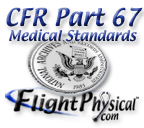Latest FAA Revision: Aug 23, 2006 |
|||
20/20 or better in each eye separately, with or without correction. More... |
20/40 or better in each eye separately, with or without correction. |
||
20/40 or better in each eye separately (Snellen equivalent), with or without correction, as measured at 16 inches. More... |
|||
20/40 or better in each eye separately (Snellen equivalent), with or without correction at age 50 and over, as measured at 32 inches. More... |
No requirement. |
||
Ability to perceive those colors necessary for safe performance of airman duties. More... |
|||
Demonstrate hearing of an average conversational voice in a quiet room, using both ears at 6 feet, with the back turned to the examiner or pass one of the audiometric tests below. More... |
|||
Audiometric speech discrimination test: Score at least 70% reception in one ear.Pure tone audiometric test. Unaided, with thresholds no worse than shown: More... |
|||
No ear disease or condition manifested by, or that may reasonably be expected to maintained by, vertigo or a disturbance of speech or equilibrium. More... |
|||
Not disqualifying per se. Used to determine cardiac system status and responsiveness. More... |
|||
No specified values stated in the standards. The current guideline maximum value is 155/95. More... |
|||
| Electrocardiogram (ECG) | At age 35 and annually after age 40 (first-class only) More... | Not routinely required. (second- and third-class only) | |
| Mental | No diagnosis of psychosis, or bipolar disorder, or severe personality disorders. More... |
||
| Substance Dependence and Substance Abuse | A diagnosis or medical history of substance dependence is disqualifying unless there is established clinical evidence, satisfactory to the Federal Air Surgeon, of recovery, including sustained total abstinence from the substance(s) for not less than the preceding 2 years. A history of substance abuse within the preceding 2 years is disqualifying. Substance includes alcohol and other drugs (i.e., PCP, sedatives and hynoptics, anxiolytics, marijuana, cocaine, opioids, amphetamines, hallucinogens, and other psychoactive drugs or chemicals). |
||
Note: For further information, find an AME or have him/her contact the Regional Flight Surgeon. |
|||
Exam Info | Online Scheduling Info | Find AME | Pilot FAQs | Sport Pilots | Part 67 Medical Standards | Blood Pressure | Part 61 Flight Certification |DUI | Waivers
How Site Works | Online Scheduling | Update my Page | Links | Prices | Email | Pay Bill | AME FAQs | Trade Equipment | AME Guide
Pilot FAQs | AME FAQs | FAQ's By Medical Problem | Sport Pilot | Blood Pressure | Scheduling | Contact Us
Exam Info | Synopsis of Standards |CFR Part 67 | Exam Classes | Class 1 Requirements | Class 2 | Class 3 | Problem List | Waivers | Blood Pressure
subglobal6 link | subglobal6 link | subglobal6 link | subglobal6 link | subglobal6 link | subglobal6 link | subglobal6 link

